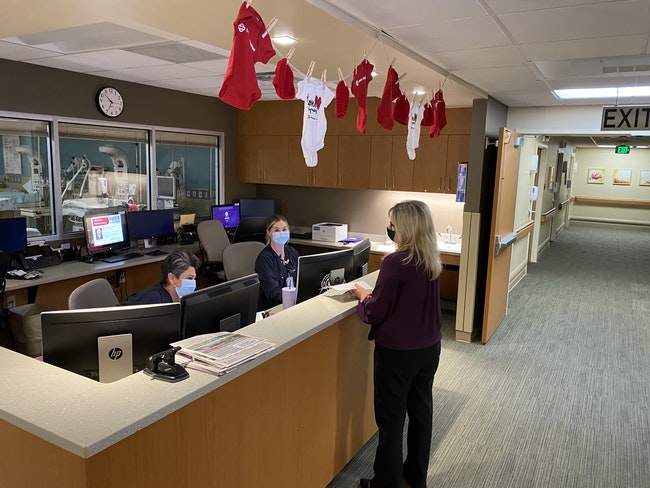
Registered nurses Juanita Lopez (left) and Kayla McPheeters brief Dina Ellwanger on overnight activities in the obstetrics department on Wednesday, May 26. (The Enterprise/Les Zaitz)
ONTARIO – The nurses in the emergency department appeared drained from their overnight shift at Saint Alphonsus Medical Center Ontario.
They and the doctors had a busy night on a recent Tuesday – 32 patients flowed through.
As they prepared to turn over patient care to their daytime colleagues, a familiar face showed at about 6:30 a.m.
Dina Ellwanger, the hospital president and herself a registered nurse, asked how the night had gone.
The nurses, fatigue in their faces, knew they were talking to one of their own. But they also knew they were talking to an executive who would listen and act.
Ellwanger picked up on disconcerting cues that the shift hadn’t gone as well as it could. She was soon texting another hospital administrator, working to learn more.
For Ellwanger, that morning stop in the emergency room is part of a routine that takes her through every part of the hospital. She’s taking the temperature, so to speak, of the night crew – alert to issues, problems and praises.
And it is that close attention to detail that this year vaulted Saint Alphonsus into rare company – rated among the top 100 hospitals in the U.S.
The ranking was issued by IBM Watson, a national company that annually evaluates hospitals of all sizes to prepare the rankings. It does so in part to identify the best hospitals and tease out lessons for others on what it takes to provide good patient care and operate as a sound business.
Saint Alphonsus made the top tier for the first time – a “phenomenal job” is the way Ekta Punwani of IBM Watson describes it. She said the Ontario hospital ranked high among 834 small community hospitals included in the study of hospitals of all sizes.
“They have been focusing on improvement,” said Punwani. “They have been improving year over year and that’s very important.”
IBM Watson has been providing the rankings for 28 years. The prime focus is on results in patient care – how long people stay, whether they have to return for additional treatment, and how fast emergency care is provided.
Those in the top 100 posted strong scores in those areas. The ratings are done independently with no input from the hospitals.
“We believe that in order to achieve really good outcomes, you have to have strong leadership but also a really strong culture within the hospital for improvement, for meeting patient needs,” Punwani said. “These top-rated organizations really demonstrated that.”
 Dina Ellwanger participates in an early morning “safety huddle” at Saint Alphonsus Medical Center Ontario on Wednesday, May 26. The huddles provide a check with every department at the hospital to learn of issues that need attention. (The Enterprise/Les Zaitz)
Dina Ellwanger participates in an early morning “safety huddle” at Saint Alphonsus Medical Center Ontario on Wednesday, May 26. The huddles provide a check with every department at the hospital to learn of issues that need attention. (The Enterprise/Les Zaitz)
At Saint Alphonsus, that leadership starts in Ellwanger’s ground floor corner office – a tidy desk, encouraging signs and a shelf of books about leadership and excellence.
Weekdays, she typically arrives at the hospital sometime between 5:30 a.m. and 6 a.m.
She does so, she said, because she’s “passionate” about seeing those on night shift before they clock out.
Ellwanger avoids her computer and office work, knowing she would sit down and likely never get up from the steady flow of emails and reports.
As she moves through the hospital, which dates to 1912 as Holy Rosary, Ellwanger greets each employee by name.
“How was your night?” she asks.
She is short, energetic and moves at a quick pace. She talks as fast as she walks.
Charlie Brizzee, the hospital’s quality and patient safety manager, said her style helps set the tone.
Brizzee himself tours the hospital each day, though not as early as Ellwanger.
“You can’t lead from your chair,” he said.
Using stairs more than elevators, Ellwanger makes her way through the departments, including medical-surgery, intensive care, and obstetrics.
There, on a recent morning, she paused to talk with nurses Juanita Lopez and Kayla McPheeters, sitting at a work station with Saint Alphonsus babywear dangling like holiday lights across the ceiling.
She then encounters a hallway staff huddle in the medical-surgery department, and surprises nurse Catherine Garbarino with a “Daisy award.” She was nominated for the in-house honor by a colleague.
“She regularly shows kindness and compassion towards all of her patients, and in turn motivates me to strive to provide that type of exemplary care,” the nomination read. “I have never nominated one of my nurses for a Daisy Award. But to not make note of Catherine’s excellence would be negligent of me.”
Ellwanger huddles in the hallway with a department manager and then moves on. She will check in on the surgery unit, the laboratory, and the cancer treatment unit.
Ellwanger succeeded Ken Hart as hospital president about a year ago. Hart, too, used to tour the hospital but Ellwanger’s medical training allows her to detect issues that might escape other executives.
Meetings and “huddles” are crucial to providing the strong patient outcomes noted not only by IBM Watson but by federal regulators, who have ranked Saint Alphonsus as a five-star hospital – among the best in the country.
Each morning, key departments join in a call to review the patient census. The intent is to ensure that planning for a patient’s release is in the works – even if they were just admitted.
The care providers report patient by patient – when they will be discharged, what kind of care they will need afterward, and who will provide that care. If a patient will need oxygen at home, for instance, the hospital team prepares for that while the patient is still being cared for.
One of the closely-watched numbers at any hospital is the readmission rate. That means a patient has been treated, released, and then has to return for additional care. Hospitals work hard to ensure they don’t have to check a patient back in.
“If we don’t do the job right the first time and they have to come back, shame on us,” Ellwanger said.
She said there is a financial incentive as well – hospitals aren’t paid for subsequent care they provide if a patient comes back within 30 days.
That readmission rate, Ellwanger said, “is a very strong gauge of how we’re doing.”
Punwani said Saint Alphonsus was doing “really well” on that measure. “They’re really leading.
Still in the morning, Ellwanger joins a virtual “safety huddle.” Every department is represented in a quick-fire round. Each person tells their department, how many days have gone without an employee injury, any hospital-acquired medical conditions and – most often – “no issues to report.” If an issue crops up, the conversation is quick, focused on solutions or shunted ahead to a separate “offline” meeting.
The huddles and meetings keep employees alert to problems or even potential problems.
Other regular reports help Ellwanger and her team keep on top of an institution that in a year will see about 14,000 emergency room patients, admit 2,400, and perform nearly 2,000 surgeries.
Brizzee watches for “surgical site infection” and “hospital acquired infection” reports, documenting a patient who became infected in the hospital.
Such reports trigger a meticulous step-by-step review of every movement, process and piece of equipment used in a patient’s treatment.
“Somewhere there was a failure point,” Brizzee said.
The audit tries to detect if procedures weren’t followed – something didn’t get sterilized, or some step in the process was missed. Often, he said, a glitch is found that can be fixed.
If it’s not a breach in procedures, then the infection was caused by human error, Brizzee said. Tracking down what happened is essential to see it doesn’t happen again.
But Ellwanger and her team are also determined to keep morale high with such steps as the Daisy award. There are the Thursday kudos and “ICARE” accounts of extra performance. Such recognition spotlights employees but also provides a chance for others to learn – what Brizzee refers to as the “recipes of success.”
That care shows up in the numbers that measure just about everything in the hospital.
One is the percentage of patients who would recommend the hospital to others. For Saint Alphonsus, that stands at about 70% – ahead of the national average and on par with other highly rated community hospitals.
Ellwanger said she wants to move that higher – closer to 80%. She said her team fights a legacy stretching back to prior owners from more than a decade ago, when the hospital’s reputation suffered.
She recently met a patient in the hospital who shared with her a reluctance to return to the hospital for care again because of an earlier experience.
“I’m so glad I gave you another shot,” the patient told her.
In other than pandemic times, Ellwanger’s leadership team makes a point to see every patient while in the hospital – and then gets a call from senior hospital leaders after they are discharged to home or another location.
And when Ellwanger finally heads for home herself, she’s not yet done with work. After dinner, she goes on her computer, spending a couple of hours clearing out emails and tending to other tasks.
She was at home in April, doing her routine catching up, when she spotted the email from IBM Watson. The message, which had arrived earlier in the day but had gone unnoticed, alerted Ellwanger of the hospital’s new ranking.
She said she read it aloud to her husband Scot, “asking him if he thought it was legitimate.” She forwarded it to another Saint Alphonsus colleague in Boise, who assured her it was real.
Ellwanger then shared the news with her Saint Alphonsus team.
“It means a lot to the staff,” Ellwanger said.
She said she expects the hospital will continue to improve.
“I have never felt so confident in my team,” she said.
Contact editor Les Zaitz by email: [email protected].
RELATED COVERAGE:
PHOTOS: Meetings online and in hallways are key to quality control at Saint Alphonsus
SAFEGUARD YOUR LOCAL NEWS
Take one action today to help the Enterprise grow and do more for the community through accurate, fair reporting.
SUBSCRIBE: A monthly digital subscription is $5 a month.
GIFT: Give someone you know a subscription.
DONATE: Contribute, knowing your support goes towards more local journalism you can trust. Whether it’s $25 or $250, we put it to good purposes.




